1958 FIFA World Cup
| Världsmästerskapet i Fotboll Sverige 1958(Swedish) | |
|---|---|
 | |
| Tournament details | |
| Host country | Sweden |
| Dates | 8–29 June |
| Teams | 16 (from 3 confederations) |
| Venue(s) | 12 (in 12 host cities) |
| Final positions | |
| Champions | |
| Runners-up | |
| Third place | |
| Fourth place | |
| Tournament statistics | |
| Matches played | 35 |
| Goals scored | 126 (3.6 per match) |
| Attendance | 819,810 (23,423 per match) |
| Top scorer(s) | |
The1958 FIFA World Cupwas the sixthFIFA World Cup,a quadrennialfootballtournament for men's senior national teams. It was played in Sweden from 8 to 29 June 1958. It was the first and only FIFA World Cup to be played in aNordic country.
BrazilbeatSweden5–2 in thefinalinSolna,Stockholm,to claim their first title, having beatenFrancein the semi-final andWalesin the quarter-final. The tournament also marked the arrival of a then 17-year-oldPeléon the world stage, who scored in all three of Brazil's knockout games.
This was the first appearance ofWalesat the FIFA World Cup. They would not qualify for another until64 years later.This tournament also marked the debuts of fellow British sideNorthern Ireland,as well as theSoviet Union.Defending championsWest Germanywere eliminated by runners-up Sweden and would lose toFrancein a third place match.
Host selection
[edit]Argentina, Chile, Mexico, and Sweden expressed interest in hosting the tournament.[1]Swedish delegates lobbied other countries at the FIFA Congress held inRio de Janeiroaround the opening of the1950 World Cup finals.[1]Sweden was awarded the 1958 tournament unopposed on 23 June 1950.[2]
Qualification
[edit]The hosts (Sweden) and the defending champions (West Germany) qualified automatically. Of the remaining 14 places, nine were allocated to Europe, three to South America, one to North/Central America, and one to Asia/Africa.
Aside from the main European zone matches,Wales,which finished second in its group behindCzechoslovakia,was drawn into a play-off withIsraelafter Israel won its group by default because its three opponents,Turkey,IndonesiaandSudan,refused to play. FIFA had imposed a rule that no team would qualify without playing at least one match, something that had happened in several previous World Cups. Wales won the play-off and qualified for the first time. WithNorthern Irelandmaking its debut, andEnglandandScotlandalso qualifying, this World Cup was the only one to date to feature all four of theUnited Kingdom'sHome Nations.
This World Cup also saw the entry and qualification of theSoviet Unionfor the first time, while Argentina appeared for the first time since1934.It was also the first one for whichItalyfailed to qualify (Italy did not take part in the1930 tournamentbut there was no qualification for that competition). Other teams that failed to qualify included two-time champions and1954semifinalistsUruguay,as well asSpainandBelgium.
On 8 February 1958, inSolna,Lennart HylandandSven Jerringpresented the results of the draw where the qualified teams were divided into four groups. Seeding was geographical rather than by team strength, with each group containing one western European team, one eastern European team, one of the four British teams that had qualified, and one from the Americas.[3]
List of qualified teams
[edit]The following 16 teams qualified for the final tournament.
|
AFC(0)
CAF(0)
|
NAFC(1) CCCF(0)
CONMEBOL(3) |
UEFA(12)
|

|
Format
[edit]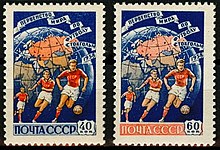
The format of the competition changed from1954:16 teams still competed in four groups of four, but this time each team played each of the other teams in its group at least once, without extra time in the event of a draw. Two points were awarded for a win and one point for a draw. If the first two teams finished on equal points, thengoal averagewould decide who was placed first and second. As in 1954, if the second and third-placed teams finished on the same points, then there would be a play-off with the winner going through. If a play-off resulted in a draw, goal average from the group games would be used to determine who went through to the next round. If the goal averages were equal, then lots would have been drawn. By the time the competition began, these arrangements were still in discussion. Some teams complained that a play-off match, meaning three games in five days, was too much, and before the second round of group matches, FIFA informed the teams that goal average would be used before resorting to a play-off.[4]This was overturned when theSwedish Football Associationcomplained, stating that it was wrong to change the rules mid-tournament, but also because it wanted the extra revenue from playoff matches.[4]
This was the first time that goal average was available to separate teams in a World Cup. It was used to separate the teams finishing first and second in one of the groups. However, all three playoffs finished with decisive results and so it was not needed to separate the teams involved in a tied playoff.
Almost all the matches kicked off simultaneously in each of the three rounds of the group phase, as did the quarter-finals and semi-finals. The exceptions were Sweden's three group matches, all of which were televised bySveriges Radio;these started at other times so Swedes could attend other matches without missing their own team's. Apart from these, one match per round was televised, and relayed across Europe by theEuropean Broadcasting Union(EBU). Many Swedes bought their first television for the World Cup.
The official ball was the "Top-Star VM-bollen 1958" model made by Sydsvenska Läder & Remfabriks AB (aka "Remmen" or "Sydläder" ) inÄngelholm.Four FIFA officials conducted a blind test to choose it from 102 candidates.[5][6]
Summary
[edit]
In Group 4,PeléandGarrinchadid not play until the last ofBrazil's group games, against theSoviet Union.[7]Pelé failed to score, but provided the assist toVavá'ssecond goal.[8][9]Brazil won the game 2–0 (also thanks to an impressive exhibition of dribbling prowess by Garrincha) and the group by two points. Previously, they had drawn 0–0 with England in what was the first ever goalless game in World Cup history. Eventually, the Soviet Union and England went to a playoff game, in whichAnatoli Ilyinscored in the 67th minute to knock England out, whileAustriahad already been eliminated. The English side had been weakened by theMunich air disasterearlier in the year, which killed three internationals on the books ofManchester United,including England's young starDuncan Edwards.
Playoffs were also needed in Group 1 (Northern IrelandbeatCzechoslovakiato join the defending championsWest Germanyin the quarter-finals) and Group 3 (WalestoppedHungaryto advance with hostsSweden). Hungary had become a spent force after their appearance in the final of the previous tournament. They had lost their best players two years before, when they fled in the wake ofthe failed uprisingagainst the communist regime. In a rather restrictive sense, from the 1954 team, only goalkeeperGyula Grosics,defenderJozsef Bozsikand forwardNándor Hidegkutiremained.
In Group 2,ScotlandfacedYugoslavia,Paraguay,andFrance.France topped the group, withJust Fontainenetting six goals. Yugoslavia finished second, while Scotland came in last.
The quarter-finals saw France's Just Fontaine continue in similar form as in the group stage, managing another two goals as France triumphed over Northern Ireland. West Germany'sHelmut Rahnput them into the semi-finals with a single goal against Yugoslavia, while Sweden went through at the expense of USSR. The other game in the quarter-finals saw Pelé score the only goal for Brazil against Wales.
In the semi-finals, Sweden continued their strong run as they defeated West Germany 3–1 in a vicious game that saw the German playerErich Juskowiaksent off (the first ever German player to be sent off in an international game) and German veteran forwardFritz Walterinjured, which further weakened the German team (substitutes were first allowed in the1970 FIFA World Cup).
In the other semi-final, Brazil and France were tied 1–1 for much of the first half. However, 36 minutes into the game, French captain and most experienced defenderRobert Jonquetsuffered a broken leg in a clash with Vavá, and France was down to ten men for the rest of the game, (substitutions were not allowed back then). Brazil dominated the rest of the match, as a Pelé hat-trick gave them a 5–2 victory. Fontaine of France added one goal to his impressive tally.
The third-place match saw Fontaine score four more goals as France defeated West Germany 6–3. This brought his total to 13 goals in one competition, a record that still stands.
Final
[edit]Thefinalwas played inSolna,in theRåsunda Stadium;50,000 people watched as the Brazilians went a goal down after four minutes. However,Vaváequalised shortly afterwards and then put them a goal ahead before half time. In the second half, Pelé outshone everyone, notching two goals, including the first one where he lobbed the ball overBengt Gustavssonthen followed it with a precise volley shot.Zagalloadded a goal in between, and Sweden managed a consolation goal.
The Final saw many records made in World Cup history that still stand as of 2018[update].At age 17, Pelé simultaneously became the youngest player to participate in, score, and win a World Cup final. Conversely,Nils Liedholmbecame the oldest player to score in a World Cup Final at 35 years 263 days. This final had the highest number of goals scored by a winning team (5), the highest number of total goals scored (7), and together with the1970and1998finals shares the highest goal margin of difference (3); Brazil played in all those three finals.
The game is also notable for many firsts in FIFA World Cup. With the exception of the1950 FIFA World Cupfinal group stage, this marked the first time that a World Cup host reached the final without winning it. Additionally, the match marked the first time two nations from different continents (Europe and South America) met in a World Cup final. It also marks the first and only World Cup hosted in Europe not won by a European team, a feat mirrored in2014where a World Cup hosted in theAmericaswas not won by a team from the Americas for the first time, withGermany beating Argentina 1–0 at the final.
Venues
[edit]A total of twelve cities throughout the central and southern parts of Sweden hosted the tournament. FIFA regulations required at least six stadiums to have a capacity of at least 20,000.[10]IfDenmarkhad qualified, the organisers had planned to use theIdrætsparkeninCopenhagenfor Denmark's group matches.[10]The Idrætsparken was renovated in 1956 with this in mind, but Denmark lost out to England in qualification.[10]When doubts arose about whether funding would be forthcoming for rebuilding theUlleviandMalmö Stadion,the organisers considered stadiums in Copenhagen andOsloas contingency measures.[11]
The Råsunda Stadium was expanded from 38,000 for the World Cup by building end stands.[12]Organising committee chairman Holger Bergérus mortgaged his house to pay for this.[12]The new Malmö Stadion was built for the World Cup, replacing the 1896 Malmö Stadion at a new site.[13]The Idrottsparken had 4,709 seats added for the World Cup. TheSocial Democraticmunicipal government refused to pay for this until the organisers threatened to selectFolkungavalleninLinköpinginstead.[14]At the Rimnersvallen, a stand from the smaller Oddevallen stadium was moved to Rimnersvallen for the World Cup. The crowd at Brazil v. Austria was estimated at 21,000, with more looking in from the adjoining hillside.[12]The most used stadium was the Råsunda Stadium in Stockholm, which hosted 8 matches, including the final, followed by the Ullevi Stadium in Gothenburg (the biggest stadium used during the tournament), which hosted 7 matches. The Malmö Stadium hosted 4 matches, Norrköping hosted 3 matches; Borås, Halmstad, Helsingborg, Västerås, and Sandviken hosted 2 matches each, and Örebro, Eskilstuna, and Uddevalla each hosted 1 match.
| Gothenburg |
|---|
| Ullevi Stadium |
| Capacity:53,500 |

|
| Eskilstuna |
| Tunavallen |
| Capacity:22,000 |
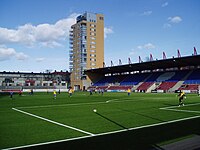
|
| Sandviken |
| Jernvallen |
| Capacity:20,000 |
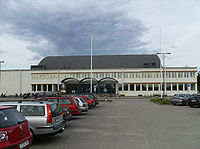
|
| Borås |
| Ryavallen |
| Capacity:15,000 |
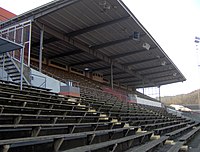
|
| Helsingborg |
|---|
| Olympia |
| Capacity:27,000 |

|
| Norrköping |
| Idrottsparken |
| Capacity:20,000 |
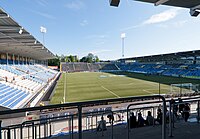
|
| Uddevalla |
| Rimnersvallen |
| Capacity:17,778 |

|
| Västerås |
| Arosvallen |
| Capacity:10,000 |

|
| Solna (Stockholmarea) |
Malmö |
|---|---|
| Råsunda Stadium | Malmö Stadion |
| Capacity:52,400 | Capacity:30,000 |

|

|
| Halmstad | Örebro |
| Örjans Vall | Eyravallen |
| Capacity:15,000 | Capacity:13,000 |

|
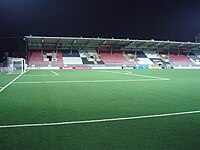
|
Match officials
[edit]22 match officials were assigned to the tournament to serve as referees and assistant referees.
Europe
 Fritz Seipelt
Fritz Seipelt Lucien van Nuffel
Lucien van Nuffel Martin Macko
Martin Macko Carl Jørgensen
Carl Jørgensen Arthur Ellis
Arthur Ellis Reginald Leafe
Reginald Leafe Arne Eriksson
Arne Eriksson Maurice Guigue
Maurice Guigue István Zsolt
István Zsolt Vincenzo Orlandini
Vincenzo Orlandini Jan Bronkhorst
Jan Bronkhorst Joaquim Campos
Joaquim Campos Jack Mowat
Jack Mowat Juan Gardeazábal Garay
Juan Gardeazábal Garay Sten Ahlner
Sten Ahlner Raymond Wyssling
Raymond Wyssling Nikolai Latyshev
Nikolai Latyshev Mervyn Griffiths
Mervyn Griffiths Albert Dusch
Albert Dusch Leo Lemešić
Leo Lemešić
South America
Seeding
[edit]There was no seeding for this World Cup; the teams were instead allocated geographically into four pots chosen by theFIFA Organising Committee.[15]Teams were drawn from each pot into Groups 1–4 in numerical order.
Preventing the defending champions from meeting the hosts in the group stage, either by seeding or predetermined group positions, was a practiced tradition throughout the history of the FIFA World Cup, with1934and1954being the only two exceptions.[15]This tradition continued in 1958, with West Germany as defending champion and host nation Sweden both being allocated into the sameWestern European Pot,which kept them from meeting in the group stage.
| Western European Pot | Eastern European Pot | British Pot | Americas Pot |
|---|---|---|---|
|
The geographical basis of the seeding attracted criticism, especially from Austria, who were drawn against the teams considered strongest in each of the other three pots.[16]
Squads
[edit]For a list of all squads that appeared in the final tournament, see1958 FIFA World Cup squads.
Group stage
[edit]Group 1
[edit]The West Germans, surprise world champions four years before, were still very strong, and fielded an exciting young forward inUwe Seeler.The Germans had to contend with a real powerhouse in Argentina's team, competing for the first time since 1934. In fact, some experts[who?]thought Argentina had a very realistic chance of reaching the semi-finals or even winning the World Cup this time. Czechoslovakia was a fairly strong team with a rich football tradition, and was considered to be no walkover for the West Germans or the Argentinians.
Nobody expected much from tiny newcomers Northern Ireland. But the Northern Irish had already shown that they could be a danger by knocking out double world champions Italy in World Cup qualifying. In the end, the Northern Irish pulled off one of the biggest upsets in World Cup Finals history by qualifying for the quarter-finals, beating Czechoslovakia in a play-off.
Argentina experienced ahorrible blowfinishing last in the group with a −5 goal differential. Arriving home, the Argentinian team met the wrath of several thousand angry football fans atEzeiza AirportinBuenos Aires.[17]
| Pos | Team | Pld | W | D | L | GF | GA | GR | Pts | Qualification |
|---|---|---|---|---|---|---|---|---|---|---|
| 1 | 3 | 1 | 2 | 0 | 7 | 5 | 1.400 | 4 | Advance toknockout stage | |
| 2 | 3 | 1 | 1 | 1 | 4 | 5 | 0.800 | 3 | ||
| 3 | 3 | 1 | 1 | 1 | 8 | 4 | 2.000 | 3 | ||
| 4 | 3 | 1 | 0 | 2 | 5 | 10 | 0.500 | 2 |
- Northern Ireland finished ahead of Czechoslovakia by winning a play-off
| West Germany | 2–2 | |
|---|---|---|
| Schäfer Rahn |
Report | Dvořák Zikán |
| West Germany | 2–2 | |
|---|---|---|
| Rahn Seeler |
Report | McParland |
Play-off
[edit]| Northern Ireland | 2–1 (a.e.t.) | |
|---|---|---|
| McParland |
Report | Zikán |
Group 2
[edit]The second group saw the largest number of goals scored in a single group in the 1958 World Cup, with 31 goals in total (~5.16 goals per game). Just Fontaine of France scored 6 of his 13 goals in the tournament, making him the tournament's top scorer going into the quarter-finals.
The teams in this group had not seen significant success in past World Cups. France, even as hosts in1938,did not secure notable achievements; Yugoslavia failed to match their 1930 semi-final run, and both Paraguay and Scotland entered the tournament as underdogs.
France won the group ahead of Yugoslavia and would go on to finish third.
| Pos | Team | Pld | W | D | L | GF | GA | GR | Pts | Qualification |
|---|---|---|---|---|---|---|---|---|---|---|
| 1 | 3 | 2 | 0 | 1 | 11 | 7 | 1.571 | 4 | Advance toknockout stage | |
| 2 | 3 | 1 | 2 | 0 | 7 | 6 | 1.167 | 4 | ||
| 3 | 3 | 1 | 1 | 1 | 9 | 12 | 0.750 | 3 | ||
| 4 | 3 | 0 | 1 | 2 | 4 | 6 | 0.667 | 1 |
- France finished ahead of Yugoslavia on goal average
| France | 7–3 | |
|---|---|---|
| Fontaine Piantoni Wisnieski Kopa Vincent |
Report | Amarilla Romero |
| Yugoslavia | 1–1 | |
|---|---|---|
| Petaković |
Report | Murray |
| Yugoslavia | 3–2 | |
|---|---|---|
| Petaković Veselinović |
Report | Fontaine |
| Paraguay | 3–3 | |
|---|---|---|
| Parodi Agüero Romero |
Report | Ognjanović Veselinović Rajkov |
Group 3
[edit]The Swedish hosts could count themselves lucky in ending up in a rather weak group, which they proceeded to win fairly easily with their powerful, workmanlike football. The group includedHungarywhich had been considered by far the best team in the world some years ago, although the Hungarians could not beatWest Germanyin the final of theWorld Cup in 1954.But the Hungarian team had been dealt a blow by theHungarian Revolution of 1956after which star players likeSándor KocsisandFerenc Puskásleft their homeland. StrikerNándor Hidegkutiwas still playing, but he was by now 36 years old and nowhere near his peak form.
In spite of Hungary's recent travails, they were still considered a strong side and were expected to advance from their group. The success ofWaleswas a surprise but they drew all their group games and beat the Hungarians in a play-off match to follow Sweden into the knock-out stage. Wales played Brazil in the quarterfinals and became the recipient of youngPelé's first World Cup goal.[18]
The 1–1 draw between Wales and Mexico was the first point scored by Mexico in a World Cup, having lost all eight matches in their previous three appearances in the World Cup, as well as their first match in this group against Sweden. To date, no other team has ever lost nine consecutive games in the World Cup.
The match between Hungary and Wales inSandvikenbecame the northernmost World Cup match in history.
| Pos | Team | Pld | W | D | L | GF | GA | GR | Pts | Qualification |
|---|---|---|---|---|---|---|---|---|---|---|
| 1 | 3 | 2 | 1 | 0 | 5 | 1 | 5.000 | 5 | Advance toknockout stage | |
| 2 | 3 | 0 | 3 | 0 | 2 | 2 | 1.000 | 3 | ||
| 3 | 3 | 1 | 1 | 1 | 6 | 3 | 2.000 | 3 | ||
| 4 | 3 | 0 | 1 | 2 | 1 | 8 | 0.125 | 1 |
- Wales finished ahead of Hungary by winning a play-off
| Hungary | 1–1 | |
|---|---|---|
| Bozsik |
Report | J. Charles |
| Mexico | 1–1 | |
|---|---|---|
| Belmonte |
Report | I. Allchurch |
Play-off
[edit]Group 4
[edit]Despite setbacks in earlier tournaments, Brazil was still regarded as a formidable force, a reputation they would go on to justify. The Soviet Union, having clinched theOlympic goldin 1956, and Austria, securing the bronze medal at the 1954 World Cup in Switzerland, were also strong contenders. England, despite being weakened by the tragicMunich air disasterthat claimed several players, remained a team of considerable strength.
In the end, this group had the highest average attendance (31,320 per game), even higher than Group 3 with the host nation, Sweden.
The quality of the football in this group did not quite live up to expectations, however. Only 15 goals were scored in the whole group, only one more than Group 3. And when England and Brazil drew 0–0, it was the first time in World Cup history that a game ended goalless. It was also the first time Brazil had failed to score in a World Cup finals match.
Brazil won the group without conceding a single goal. The teenage Pelé played Brazil's last game against the Soviet Union. He did not score but drew wild reviews for his play. The Soviet Union, in their first World Cup, took second place.
| Pos | Team | Pld | W | D | L | GF | GA | GR | Pts | Qualification |
|---|---|---|---|---|---|---|---|---|---|---|
| 1 | 3 | 2 | 1 | 0 | 5 | 0 | — | 5 | Advance toknockout stage | |
| 2 | 3 | 1 | 1 | 1 | 4 | 4 | 1.000 | 3 | ||
| 3 | 3 | 0 | 3 | 0 | 4 | 4 | 1.000 | 3 | ||
| 4 | 3 | 0 | 1 | 2 | 2 | 7 | 0.286 | 1 |
- The Soviet Union finished ahead of England by winning a play-off
| Brazil | 3–0 | |
|---|---|---|
| Altafini Nílton Santos |
Report |
| Soviet Union | 2–0 | |
|---|---|---|
| Ilyin V. Ivanov |
Report |
| Brazil | 2–0 | |
|---|---|---|
| Vavá |
Report |
Play-off
[edit]| Soviet Union | 1–0 | |
|---|---|---|
| Ilyin |
Report |
Knockout stage
[edit]Bracket
[edit]| Quarter-finals | Semi-finals | Final | ||||||||
| 19 June – Gothenburg | ||||||||||
| 1 | ||||||||||
| 24 June – Solna | ||||||||||
| 0 | ||||||||||
| 5 | ||||||||||
| 19 June – Norrköping | ||||||||||
| 2 | ||||||||||
| 4 | ||||||||||
| 29 June – Solna | ||||||||||
| 0 | ||||||||||
| 5 | ||||||||||
| 19 June – Solna | ||||||||||
| 2 | ||||||||||
| 2 | ||||||||||
| 24 June – Gothenburg | ||||||||||
| 0 | ||||||||||
| 3 | ||||||||||
| 19 June – Malmö | ||||||||||
| 1 | Third place play-off | |||||||||
| 1 | ||||||||||
| 28 June – Gothenburg | ||||||||||
| 0 | ||||||||||
| 6 | ||||||||||
| 3 | ||||||||||
Quarter-finals
[edit]| Sweden | 2–0 | |
|---|---|---|
| Hamrin Simonsson |
Report |
| West Germany | 1–0 | |
|---|---|---|
| Rahn |
Report |
Semi-finals
[edit]Third place play-off
[edit]| France | 6–3 | |
|---|---|---|
| Fontaine Kopa Douis |
Report | Cieslarczyk Rahn Schäfer |
Final
[edit]Goalscorers
[edit]With 13 goals, Just Fontaine was the top scorer in the tournament. As of 2022[update],no player has ever scored more goals in a single FIFA World Cup Final stage. In total, 126 goals were scored by 60 players, with none of them credited as an own goal.[19]
13 goals
6 goals
5 goals
4 goals
3 goals
2 goals
1 goal
 Ludovico Avio
Ludovico Avio Norberto Menéndez
Norberto Menéndez Karl Koller
Karl Koller Alfred Körner
Alfred Körner Didi
Didi Nílton Santos
Nílton Santos Mário Zagallo
Mário Zagallo Jiří Feureisl
Jiří Feureisl Tom Finney
Tom Finney Johnny Haynes
Johnny Haynes Yvon Douis
Yvon Douis Jean Vincent
Jean Vincent József Bencsics
József Bencsics József Bozsik
József Bozsik Károly Sándor
Károly Sándor Jaime Belmonte
Jaime Belmonte Wilbur Cush
Wilbur Cush Cayetano Ré
Cayetano Ré Sammy Baird
Sammy Baird Bobby Collins
Bobby Collins Jackie Mudie
Jackie Mudie Jimmy Murray
Jimmy Murray Aleksandr Ivanov
Aleksandr Ivanov Valentin Ivanov
Valentin Ivanov Nikita Simonyan
Nikita Simonyan Gunnar Gren
Gunnar Gren Lennart Skoglund
Lennart Skoglund John Charles
John Charles Terry Medwin
Terry Medwin Hans Cieslarczyk
Hans Cieslarczyk Radivoje Ognjanović
Radivoje Ognjanović Zdravko Rajkov
Zdravko Rajkov
All-Star Team
[edit]The team of the tournament voted by journalists was as follows:[20][21][22]
- Goalkeeper:Harry Gregg
- Defenders:Orvar Bergmark,Hilderaldo Bellini,Nílton Santos
- Midfielders:Yuriy Voynov,Horst Szymaniak
- Forwards:Garrincha,Didi,Raymond Kopa,Pelé,Lennart Skoglund
AlthoughJust Fontainegot more votes than any other forward, they were split between the left and rightinside forwardpositions.[20]The All-Star Team scored 12 goals in total. Fontaine scored 13.
FIFA retrospective ranking
[edit]In 1986, FIFA published a report that ranked all teams in each World Cup up to and including 1986, based on progress in the competition, overall results and quality of the opposition.[23][24]The rankings for the 1958 tournament were as follows:
| R | Team | G | P | W | D | L | GF | GA | GD | Pts. |
|---|---|---|---|---|---|---|---|---|---|---|
| 1 | 4 | 6 | 5 | 1 | 0 | 16 | 4 | +12 | 11 | |
| 2 | 3 | 6 | 4 | 1 | 1 | 12 | 7 | +5 | 9 | |
| 3 | 2 | 6 | 4 | 0 | 2 | 23 | 15 | +8 | 8 | |
| 4 | 1 | 6 | 2 | 2 | 2 | 12 | 14 | −2 | 6 | |
| Eliminated in the quarter-finals | ||||||||||
| 5 | 3 | 5 | 1 | 3 | 1 | 4 | 4 | 0 | 5 | |
| 6 | 4 | 5 | 2 | 1 | 2 | 5 | 6 | −1 | 5 | |
| 7 | 1 | 5 | 2 | 1 | 2 | 6 | 10 | −4 | 5 | |
| 8 | 2 | 4 | 1 | 2 | 1 | 7 | 7 | 0 | 4 | |
| Eliminated in the group stage | ||||||||||
| 9 | 1 | 4 | 1 | 1 | 2 | 9 | 6 | +3 | 3 | |
| 10 | 3 | 4 | 1 | 1 | 2 | 7 | 5 | +2 | 3 | |
| 11 | 4 | 4 | 0 | 3 | 1 | 4 | 5 | −1 | 3 | |
| 12 | 2 | 3 | 1 | 1 | 1 | 9 | 12 | −3 | 3 | |
| 13 | 1 | 3 | 1 | 0 | 2 | 5 | 10 | −5 | 2 | |
| 14 | 2 | 3 | 0 | 1 | 2 | 4 | 6 | −2 | 1 | |
| 15 | 4 | 3 | 0 | 1 | 2 | 2 | 7 | −5 | 1 | |
| 16 | 3 | 3 | 0 | 1 | 2 | 1 | 8 | −7 | 1 | |
In popular culture
[edit]The 1958 FIFA World Cup is depicted in the 2016 American filmPelé: Birth of a Legendwhich is centered around Pelé and the Brazilian team's journey to winning the tournament.[25]
References
[edit]- Norlin, Arne (2008).1958: När Folkhemmet Fick Fotbolls-VM(in Swedish). Malmö: Ross & Tegner.ISBN978-91-976144-8-1.
Citations
[edit]- ^abNorlin, pp. 24–25
- ^"FIFA World Cup: host announcement decision"(PDF).FIFA. 12 March 2009. Archived fromthe original(PDF)on 17 January 2012.Retrieved2 October2011.
- ^"History of the World Cup Final Draw"(PDF).Archived fromthe original(PDF)on 26 February 2008.Retrieved2 March2012.
- ^abNorlin, p. 117
- ^Norlin, pp. 130–6
- ^"Top Star 1958".balones-oficiales.com. Archived fromthe originalon 2 April 2012.Retrieved17 September2011.
- ^"How 17-year-old Pele conquered the world with dazzling goals as Brazil won its first World Cup in 1958".The Economic Times.30 December 2022.ISSN0013-0389.Retrieved15 March2023.
- ^"Pelé: Most Wins of the FIFA World Cup by a player".Guinness World Records.2022.Retrieved27 December2022.
- ^"Pelé leads Brazil to first World Cup title".HISTORY.2022.Retrieved27 December2022.
- ^abcNorlin, p. 23
- ^Norlin, p. 32
- ^abcNorlin, p. 27
- ^Norlin, p. 30
- ^Norlin, p. 28
- ^ab"FIFA World Cup: Seeded teams 1930–2010"(PDF).FIFA. November 2009. Archived fromthe original(PDF)on 22 July 2012.
- ^Norlin, p. 8
- ^Mundo Deportivo,23 June 1958;El Grafico,27 June 1958.
- ^"BBC Sport archive: 1958 - Wales 0-1 Brazil".1 September 2010 – via news.bbc.co.uk.
- ^"Players - Top goals".FIFA. Archived fromthe originalon 18 July 2017.
- ^abNorlin, p. 273
- ^"KOPA considerado el delantero centro del major equipo del mundo (1)"(in Spanish). Mundo Deportivo. 22 January 1959.Retrieved29 December2020.
- ^"KOPA considerado el delantero centro del major equipo del mundo (2)"(in Spanish). Mundo Deportivo. 22 January 1959.Retrieved29 December2020.
- ^"page 45"(PDF).Archived fromthe original(PDF)on 14 June 2010.Retrieved2 March2012.
- ^"FIFA World Cup: Milestones, facts & figures. Statistical Kit 7"(PDF).FIFA.26 March 2013. Archived fromthe original(PDF)on 21 May 2013.
- ^"Pelé: Birth of a Legend (2016)".Rotten Tomatoes.Fandango Media.Retrieved17 November2022.
External links
[edit]- 1958 FIFA World Cup
- FIFA World Cup tournaments
- International association football competitions hosted by Sweden
- 1957–58 in Swedish football
- 1958 in association football
- June 1958 sports events in Europe
- International sports competitions in Malmö
- International sports competitions in Gothenburg
- 1950s in Gothenburg
- 1950s in Malmö
- Sports competitions at Olympia (Helsingborg)
- Sports competitions in Sandviken
- Sports competitions in Uddevalla
- Sports competitions in Eskilstuna
- Sports competitions in Västerås
- Sports competitions in Norrköping
- Sports competitions in Borås
- Sports competitions in Örebro
- Sports competitions at Stadionområdet (Malmö)

